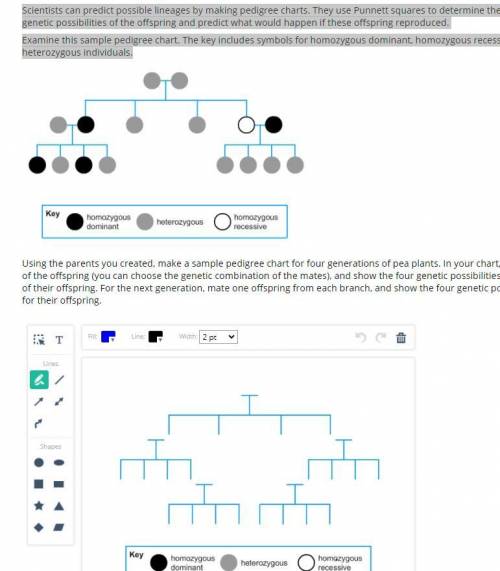
Biology, 02.06.2021 23:10 sushiboy668
Creating a Genetic Pedigree Chart
Genes regulate the shape of pea plant seeds. A pea plant produces either round or wrinkled seeds. In this activity, you will create a lineage of pea plants. You will evaluate the possibility of pea plants exhibiting dominant and recessive traits over four generations
Part A
The letter R indicates round seeds that are dominant over the wrinkled variety, represented by r. Create a Punnett square by selecting the genetic makeup of the parents. You can make the parents both hom ozygous, both heter ozygous, or a combination. Show the possible outcomes of the traits in their offspring.
Part B
Question
Scientists can predict possible lineages by making pedigree charts. They use Punnett squares to determine the four genetic possibilities of the offspring and predict what would happen if these offspring reproduced.
Examine this sample pedigree chart. The key includes symbols for hom ozygous dominant, hom ozygous recessive, and heter ozygous individuals.
Part C
Using the pedigree chart you made, explain why scientists use the word dominant for certain traits.
Part D
The lineage of pea plants produced round seeds for four generations. The plants that fertilized these pea plants also produced round seeds. However, in the fifth generation, the plant produced to two plants with wrinkled seeds. Can that be possible? Explain your answer using your pedigree chart.
Part E
Two students fertilize a pair of pea plants. One plant is Rr, and the other is rr. The offspring produced by these two plants all had the dominant trait. The Punnett square showed that there was a 50 percent chance of the offspring carrying rr genes. So, the student assumes that he made an error in determining the genetic makeup of the plants. Do you think the student made an error, or is there another explanation? Explain your answer.


Answers: 2


Another question on Biology

Biology, 21.06.2019 20:00
The deserts of the sahara and australia are associated with
Answers: 2

Biology, 21.06.2019 20:30
The collared lizard is a species found in the desert southwest. male collared lizards show considerable color variation, ranging from brightly colored to a very dull pattern. your goal is to determine the function, if any, of male color patterns in collared lizards, using the scientific method. your tentative explanation is that male color plays a role in attracting females for mating purposes. you predict that females will preferentially choose brightly colored males over dull-colored ones. to test this prediction, you observed the interactions of female collared lizards with their male counterparts. you selected males that were the same age and size, and that differed only in their coloration pattern. you placed equal numbers of the two types of male lizards, bright and dull, in aquariums, along with one female lizard per aquarium. out of 350 aquariums observed, the female chose to mate with the brightly colored male 277 times, and the dull-colored male 70 times. in 3 instances, the females did not mate with either type. create a bar graph of your data, plotting the type of male (dull or brightly colored) on the x-axis. on the y-axis, plot the frequency with which each type of male was chosen by females. using this graph, answer the following question(s). is it reasonable to conclude (i.e., is it supported by the data) that female collared lizards prefer more brightly colored male lizards over dull-colored males?
Answers: 3


Biology, 22.06.2019 10:30
10. in which phase will crossing-over occur? a. mitosis b. metaphase ii c. prophase i d. meiosis ii
Answers: 1
You know the right answer?
Creating a Genetic Pedigree Chart
Genes regulate the shape of pea plant seeds. A pea plant produces...
Questions

Mathematics, 23.03.2021 20:00






History, 23.03.2021 20:00

Social Studies, 23.03.2021 20:00


Mathematics, 23.03.2021 20:00

Spanish, 23.03.2021 20:00

Social Studies, 23.03.2021 20:00


Chemistry, 23.03.2021 20:00

Mathematics, 23.03.2021 20:00



History, 23.03.2021 20:00

Mathematics, 23.03.2021 20:00




